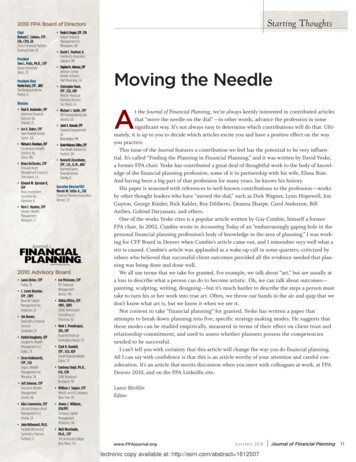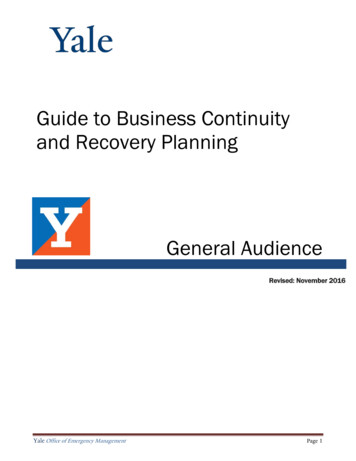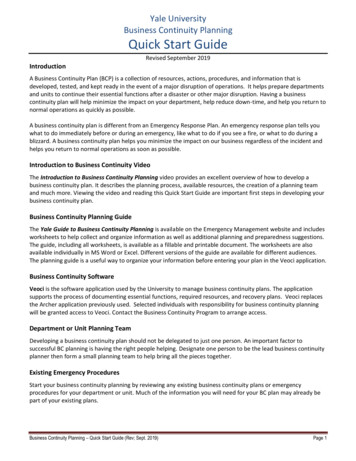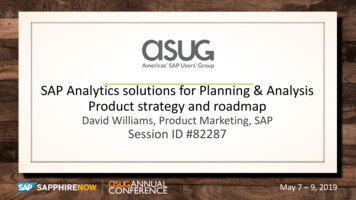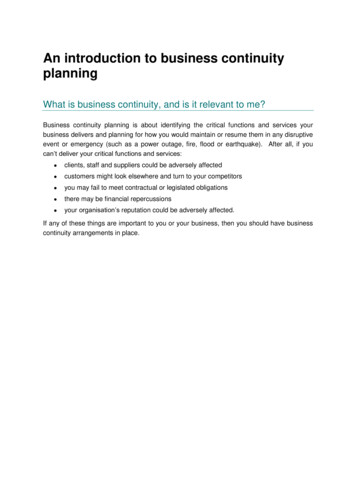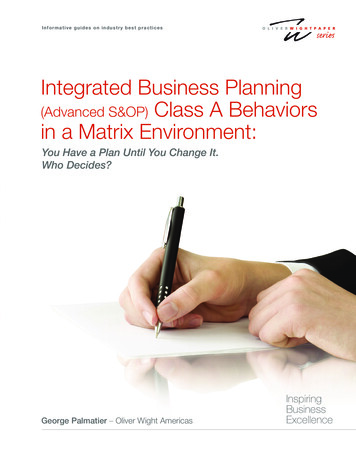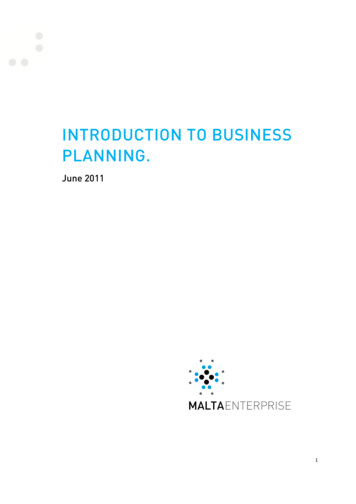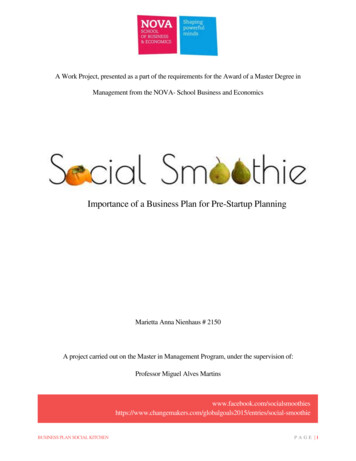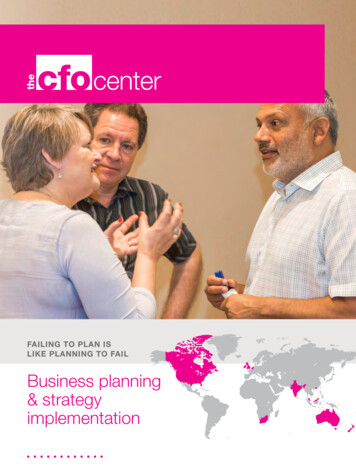
Transcription
Business AnalysisPlanning Guide
Business Analysis Planning GuideTable of ContentsppSectionOne: Introduction . . . . . . . . . . . . . . . . . . . . . . . . . . . . . . . . . . . . . . . . . . . . . . . . . . . . . . . . . . . . . . . . . . . . . . . . . . . . . . . . . . . . . . . . . . . 1I. What are the Roles of the Business Analyst?. . . . . . . . . . . . . . . . . . . . . . . . . . . . . . . . . . . . . . . . . . . . . . . . . . . . . . . . . . 1II. What is the Business Analysis Approach?. . . . . . . . . . . . . . . . . . . . . . . . . . . . . . . . . . . . . . . . . . . . . . . . . . . . . . . . . . . . . 2ppSectionTwo: Factors Impacting the Business Analysis Approach . . . . . . . . . . . . . . . . . . . . . . . . . . . . . 3ppSectionThree: Key Concepts. . . . . . . . . . . . . . . . . . . . . . . . . . . . . . . . . . . . . . . . . . . . . . . . . . . . . . . . . . . . . . . . . . . . . . . . . . . . . . . . . . . . . . . 5ppSectionFour: How to Plan for the Eight Roles . . . . . . . . . . . . . . . . . . . . . . . . . . . . . . . . . . . . . . . . . . . . . . . . . . . . . . . . . . . 8Role One: Analyzing & Documenting the Business Problem. . . . . . . . . . . . . . . . . . . . . . . . . . . . . . . . . . . . . 8Role Two: Evaluating Options & Recommending the Right Solution. . . . . . . . . . . . . . . . . . . . . . . . . 11Role Three: Identifying & Engaging Stakeholders. . . . . . . . . . . . . . . . . . . . . . . . . . . . . . . . . . . . . . . . . . . . . . . . . . . 13Role Four: Eliciting Business & Stakeholder Needs . . . . . . . . . . . . . . . . . . . . . . . . . . . . . . . . . . . . . . . . . . . . . . . . 15Role Five: Defining Requirements . . . . . . . . . . . . . . . . . . . . . . . . . . . . . . . . . . . . . . . . . . . . . . . . . . . . . . . . . . . . . . . . . . . . . . . . . 17Role Six: Facilitating Collaboration between Business & Development Teams . . . . . . 20Role Seven: Enabling Business Change & Business Value . . . . . . . . . . . . . . . . . . . . . . . . . . . . . . . . . . . . . . . 21Role Eight: Ensuring the Solution Delivers Business Value . . . . . . . . . . . . . . . . . . . . . . . . . . . . . . . . . . . . 26ppAppendix:Using the BACCM to Analyze Change. . . . . . . . . . . . . . . . . . . . . . . . . . . . . . . . . . . . . . . . . . . . . . . . . . . . . . . 29 Copyright 2013 Enfocus Solutions Inc. All Rights Reserved
Business Analysis Planning GuideSection One: IntroductionBusiness analysis is the set of tasks, knowledge, and techniques required to identifybusiness needs and determine solutions to business problems. Business analysis activitiesare the key to a successful organizational change. According to the International Institute ofBusiness Analysis (IIBA), a business analyst (BA) is anyone who performs business analysis,regardless of their title. BAs have become a valuable resource within most organizationsbecause they facilitate the completion of major business analysis activities and ensure theappropriate stakeholders remain involved with the project throughout its lifecycle.What Are the Roles of the Business Analyst?Whether a generalist or a specialist, a BA is capable of functioning competently in manydiverse roles. Typically, BAs have a broad educational background and a diverse set ofskills with a wide range of work experience in different jobs and industries. The roles of thebusiness analyst must be clearly defined and understood, since they drive the businessanalysis approach. At Enfocus Solutions Inc., we have defined the following eight roles ofthe business analyst:1. Analyzing and Documenting the Business Problem2. Evaluating Options and Recommending the Right Solution3. Identifying and Engaging Stakeholders4. Eliciting Business and Stakeholder Needs5. Defining Requirements6. Facilitating Collaboration between Business and Development Teams7. Enabling Business Change and Transformation8. Ensuring the Solution Delivers Business Value Copyright 2013 Enfocus Solutions Inc. All Rights Reserved1
Business Analysis Planning GuideWhat is the Business Analysis Approach?Organized around the previously listed eight roles, the business analysis approach describesthe overall process that should be followed when performing business analysis for a project.This guide provides analysts with instructions and considerations for planning the businessanalysis approach of a singular solution. The business analysis approach should includeinformation about how and when tasks will be performed, the techniques that will be used,and the deliverables that should be produced. By organizing the approach around the eightroles performed by the BA, the analyst can ensure the approach covers all necessary aspects.Activities related to the BA roles should be planned during the beginning stages of the project.This plan should be formally documented in a requirements management tool, like EnfocusSolutions’ RequirementPro .Planning business analysis activities is about creating a roadmap to ensure that thedelivered solution meets business and stakeholder needs and delivers value to thebusiness. The end result of business analysis planning is a business analysis plan (BAP).The BAP will provide answers to questions such as: Howwill business analysis work be executed to meet business and project objectives? Whatis the required level of rigor? Whatis the required level of detail for the requirements? Whichbusiness analysis techniques will be used? Howwill changes to requirements be managed? Howwill changes to scope will be managed? Howwill communications flow and how will issues be escalated? Howwill the deliverables and end product be verified and validated? Howwill related requirement risks be managed?As you put the plan together, remember that business analysis activities are not performedsequentially. Many tasks are performed iteratively throughout the project. Also, dependingon your project, some tasks that are performed as part of business analysis may not needto be defined at all. Copyright 2013 Enfocus Solutions Inc. All Rights Reserved2
Business Analysis Planning GuideSection two: Factors Impacting the Business Analysis ApproachBefore learning the roles of a business analyst and how to perform them, the BA shouldbecome familiar with key concepts related to business analysis and the factors impactingthe project at hand. The selected approach will vary depending on many different criteria.In developing a business analysis approach, it is important to understand the factors thatare listed below. Many of these should be considered as you create a business analysisapproach that addresses all eight roles performed by the BA.SolutionWhat, exactly, is the solution? It is important to be able to envision what the final solution willbe. The team will plan the approach differently depending on the type of solution they intendto design. For example, an approach would need to be specially tailored for certain situations,such as mergers/acquisitions, building bridges, or performing software upgrades.Purchased or BuiltWill the solution be purchased or built? If the plans are to buy a packaged solution, thebusiness analysis approach will be very different than if the organization were to build thesolution themselves. The level of detail might be much less for a built solution, becauseyour team may already be familiar with the system.OutsourcedOr, will the solution be outsourced? If the plans are to outsource solution development,requirements will need to be much more detailed and precise than if the requirementswere being delivered to in-house developers.Amount of DesignWho is going to be doing the design? Today, some organizations have their own design teamsand some do not. Often, the design team dislikes it if the BA performs design activitieshimself, like modeling or other visualization techniques. Although, sometimes the BA mustperform design activities if there is no design team. In this situation, the BA needs to becomefamiliar with and include many visualization techniques in the business analysis approach.Development LifecycleWhat is the organization’s standard development lifecycle? It is important to understandthe development lifecycle most commonly used within the organization when planningbusiness analysis activities. There may be a prescribed methodology that has alreadydetermined what business analysis activities need to be performed. Agile and waterfalldevelopment styles require different types of business analysis deliverables.Location of StakeholdersWhere are all of the solution stakeholders going to be located? This is an important factorwhen determining the stakeholder communication plan. If everyone is collocated, it willbe easier to communicate less formally than if they are spread across the globe. DispersedSMEs will require different techniques for eliciting, analyzing, and approving requirements. Copyright 2013 Enfocus Solutions Inc. All Rights Reserved3
Business Analysis Planning GuideOrganization CultureWhat is the culture within the enterprise? Different organizations have different attitudestoward formality and rigor. In some organizations, requirements are created even forsmall maintenance projects. In other organizations, requirements are not considered avalue-adding activity regardless of the size of the project. Culture will have a significantimpact on determining the right amount of requirements management for a project.Stakeholder PreferencesWhat do the stakeholders want? When communicating and collaborating with stakeholders,some may require more or less formality. A sponsor may, for example, want formal approvalfor requirements but not a documented elicitation plan of where the requirements camefrom. Some sponsors may want complete requirements traceability and others may not care.Stakeholder PoliticsAre there any politics within the organization that will affect the project? Projects withsignificant related stakeholder politics can make business analysis much more difficultand may necessitate a special approach for business analysis activities.ComplexityHow complex will the solution be? A predetermined core formal set of business analysisactivities is required in certain situations: Theproject impacts multiple business units. Thesolution will require multiple teams to build. Thereis a significant number of complex interfaces. Thereare large number and numerous types of stakeholders.Benefits RealizationWhat are the benefits that will be provided by the solution? Many organizations are usingbusiness analysts to review and evaluate benefits that were realized by the project. Theexpected benefits realization will impact many business analysis activities.Organizational ChangeAre there any organizational changes that will affect the solution? The amount oforganizational change must be considered when determining business analysis activitiesand BA techniques that should be applied.Business Process ChangeAre there any changes in the organization’s business processes that will affect the solution?Many solutions involve changing or optimizing business processes. Modifying businessprocesses may require business process modeling using BPMN, benchmarking, worksampling, applying six sigma techniques, and measuring process performance. Copyright 2013 Enfocus Solutions Inc. All Rights Reserved4
Business Analysis Planning GuideSection Three: Key ConceptsAs the BA begins to plan the business analysis approach, it is important to remain familiarwith the following key concepts:Stakeholder ExpectationsAccording to the PMBOK Guide—Fourth Edition, requirements include documented needs,wants, and expectations. Unmet stakeholder expectations can derail projects and cause themto be viewed as failures. However, delivering every want, need, and expectation increases thescope, adds significant cost and complexity, and delivers little business value. It is importantto capture needs, wants and expectations and then prioritize them in a fashion thatmakes them easily managed and implemented. It is vital that the BA remembers to addressstakeholder expectations must be addressed at all stages within the project duration.Project vs. Solution ScopeBefore preparing scope, it is important to distinguish the difference between project andsolution scope. Project Scope includes the work needed to create a product or deliver aservice or result. Project Scope defines the work required to create and deploy the product.The Project scope statement is prepared by the project manager.Solution Scope describes the characteristics, features, or functions of the product or serviceto be built. Solution scope is all about the solution to be implemented: how will it look,how will it function, and other characteristics, etc. The solution scope should be clearlydocumented in a requirements management tool, like RequirementPro . The solutionscope should be prepared with input from key stakeholders.Product vs. SolutionAlthough the industry treats product and solution interchangeably, they are actuallydifferent. The product is the end result of the project. The solution is the implementationof the requirements, which includes how the product was implemented. Keep in mindthat one product may undergo many solutions.Business Requirements vs. Solution RequirementsMany people confuse the terms business requirements and solution requirements andoften think they are the same. They are actually quite different. Business requirementsdefine what must be delivered to provide value. Solution requirements describe how theproposed solution will accomplish the business requirements. Solution requirements areone way of ensuring business requirements are satisfied. According to Robin Goldsmith inhis book, Discovering REAL Business Requirements for Software Project Success, definingbusiness requirements is the most important and, often, the poorest performed part ofsystem development. Once implemented, business requirements provide value, whichcomes from meeting business objectives through solving problems, taking opportunities,and meeting challenges. Copyright 2013 Enfocus Solutions Inc. All Rights Reserved5
Business Analysis Planning GuideBusiness requirements are written in business language and describe what must bedelivered to meet the business need. When delivered, business requirements provide valueby meeting business objectives. Solution requirements describe the high level design for asolution that is one of the possible ways to deliver the business requirements. The solutionmay work as designed but provides value only if it meets the business requirements.The IIBA’s Business Analysis Body of Knowledge (BABOK) recognizes the differencebetween business and solution requirements, sometimes referred to as system or productrequirements. However, most requirements tools vendors do not recognize the differenceand focus entirely on defining functional and nonfunctional requirements. Functional andnonfunctional requirements are solution requirements and not business requirements.Failure to recognize the difference between business and solution requirements and failureto identify and define business requirements usually results in significant scope creep anddelivering solutions that provide little business ailed)Product/System/SoftwareRequirements tailed)The model above shows the relationship between business requirements and solutionrequirements. Business requirements need to be defined in detail. They are hierarchical;and no matter how far down in detail they go, they are always business deliverables thatprovide value when delivered, satisfied, or met. However, when business requirementshave been defined in detail, then it usually is a relatively straightforward process totranslate them into a product which actually meets the business requirements andthereby avoids creep. Copyright 2013 Enfocus Solutions Inc. All Rights Reserved6
Business Analysis Planning GuideIterative and Incremental DevelopmentIf your organization does not already follow a certain development methodology, you willneed to determine the development style that is best for the project at hand and for theorganization as a whole. One very popular style of development is to create and managerequirements iteratively and incrementally.Incremental development means that new features are added in increments, or piece bypiece. For example, software can be developed using a plan-driven approach with newfunctionality sliced up into portions. In each increment, a piece of functionality is deliveredthrough cross-discipline work, from requirements development to the deployment.Incremental business analysis means that requirements are defined for an incrementand new requirements are added for each increment.Iterative development implies planned rework. Requirements are expected to evolve andchange. Therefore, changes to requirements are expected and usually viewed as part ofthe development process and not as a defect. Each iteration evaluates what has been built,and then the product is rebuilt as needed. Iterative refinement is about feedback-basedimprovement. Among other things, developing a software system is an act of learning,which means that we have a better idea of what we should have built when we’re finishedthan when we started. Each iteration implies planned rework, so there should be a processin place to accommodate changes to requirements. The diagram below shows an iterativedevelopment model.RequirementsPlanningAnalysis & ation Copyright 2013 Enfocus Solutions Inc. All Rights ReservedTesting7
Business Analysis Planning GuideSection Four: How to Plan the Eight RolesRole One: Analyzing and Documenting the Business ProblemOutput: Problem Analysis PlanThe first role a BA must perform is that of analyzing and documenting the problem that willbe addressed by the solution. When planning the business analysis approach, the BA mustdetermine which problem analysis techniques should be used to analyze the problem. Thelist of techniques that will be used to define the problem make up the problem analysis plan.By far, the easiest way to document the problem is to follow Robin Goldsmith’s ProblemPyramid . However, according to The Thinker’s Toolkit: Fourteen Powerful Techniquesfor Problem Solving by Morgan D. Jones, there are other techniques that may be useful indocumenting and analyzing the problem, as well:Problem Restatement—Simply restating a problem can broaden your perspective of theproblem, helping to identify the central issues and alternative solutions.Pro-Cons and Fixes—This six-step technique deals with the problem of negative thoughtsby compensating for negative thinking by forcing the BA to identify the positives first.Divergent/Convergent Thinking—The most common technique involving divergentthinking is to hold brainstorming workshops in which individuals can generate creativeideas about the topic at hand.Sorting, Chronologies, and Timelines—These are structuring techniques. Sorting is themost basic structuring technique. The analysis of even the simplest problems benefits fromsimple sorting. Chronologies and timelines are a couple more highly useful elementarytechniques for organizing information. These three techniques are quite simple and useful,but seldom remembered.Causal Flow Diagramming—Flow diagrams help answer the questions, “What is causingthe problem?” and, “How are the major factors interacting to produce this result?”The Matrix—A matrix is a technique that enables the BA to separate elements of a problemand then categorize and compare different types of information.The Scenario Tree—A scenario tree is a diagram that graphically shows choices and theiroutcomes at different junctures in alternative sequences or chains of events. Copyright 2013 Enfocu
Business Analysis Planning Guide Section two: Factors Impacting the Business Analysis Approach Before learning the roles of a business analyst and how to perform them, the BA should become familiar with key concepts related to busines

